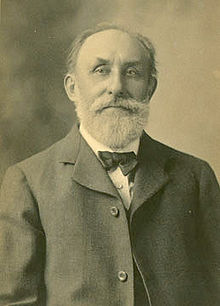Theodore Pergande
Theodore Pergande (born December 28, 1840 in Germany, † March 23, 1916 in Washington, DC ; spelling also Theodor ) was an American entomologist of German origin.
Pergande was born in Germany and trained as a locksmith. According to his own statements, he emigrated to America because a wealthy man living in his native city and future business partner wanted to marry his daughter and convert him to the Catholic faith. Pergande came to America when the Civil War broke out and ended up in New York with little knowledge of English and little money. He chose Syracuse as his next destination because a man in front of him bought a ticket in that direction at the train station and the place name did not seem unfamiliar to him. The next day he enrolled in the army and fought there for four years until the end of the war. He was discharged from the army in St. Louis , married a German and began work in a large cannon factory. On the weekends he collected butterflies and beetles. He met Otto Lugger (1844-1901), who wanted to give up his job as an assistant to Charles Valentine Riley (1843-1895). Lugger recommended Pergande as a new assistant. Along with Riley Pergande went in 1878 from Missouri to Washington to the only 16 years ago by Abraham Lincoln founded United States Department of Agriculture (USDA). Riley's second assistant, Leland Ossian Howard (1857–1950), recommended Pergande to improve his English skills reading "classical" works by Shakespeare and Edmund Spenser . Subsequently, the reports of the Bureau of Entomology appeared in the style of Spenser's Faerie Queene and similar masterpieces of English poetry of the 16th and 17th centuries.
Pergande dealt mainly with aphids and their way of life, but was also interested in other sap-sucking insects, such as fringed winged (Thysanoptera). He described new species, for example the Thrips Frankliniella occidentalis in 1895 , which was only found in a few US states at the time, but which was to spread worldwide at the end of the 20th century and is now feared as a plant virus-transmitting thrips. Pergande was known both for his precise work in the preparation of the smallest insects as well as in the observation of living objects. His work was the basis for many publications by Riley and colleagues, while he himself published little. Pergande is one of the first members of the Entomological Society of Washington, founded by Riley, Howard and Eugene Amandus Schwarz in 1884 . From 1886 to 1889 he was a member of the company's Executive Committee. After Riley's death, Pergande remained curator of the United States National Collection of Aphididae at the USDA until 1915.
His private interest was in the ants . Pergande was internationally known in this field as well. He worked mainly with ant specialists from Europe, in particular with the Austrian Gustav Mayr (1856–1911), the Italian Carlo Emery (1848–1925) and the Swiss Auguste Forel . Pergande described many new species for North America. After Pergande's death, his daughter Laura donated the ant collection to the Bureau of Entomology, whose director at the time was Pergande's former colleague and Riley assistant, LO Howard. Howard forwarded the collection, which was classified as very valuable, to the National Museum of Natural History . Most of the animals have labels that only have a number in addition to the location and year. The accompanying extensive notes were lost, however, because the family did not consider them valuable.
In honor of Pergande, aphids and ants as well as other insects were described with the species name pergandei during his lifetime, but also later .
Important scientific work
- 1894: On a collection of Formicidae from Lower California and Sonora, Mexico . Proc. Calif. Acad. Sci. ser. 2, 4: 23-36.
- 1904: Formicidae of the expedition. Harriman Alaska Expedition 9 . Inst. Pt. 2: 113-117 (reprinted from Proceedings of the Washington Academy of Sciences 2: 519-521).
Individual evidence
- ↑ Mallis, Arnold (1967): Theodore Pergande (1840-1916) - An early federal entomologist . Entomological News 78 (5): 113-116
- ^ Spilman, TJ (1984): Vignettes of 100 years of the Entomological Society of Washington . Proceedings of the Entomological Society of Washington 86 (1): 1-10.
- ↑ Gurney, Ashley B. (1976): A short history of the Entomological Society of Washington . Proceedings of the Entomological Society of Washington 78 (3): 225-239.
- ^ Smith, Marion R. (1967): Theodore Pergande - Early student of ants . Entomological News 78 (5): 117-122
| personal data | |
|---|---|
| SURNAME | Pergande, Theodore |
| ALTERNATIVE NAMES | Pergande, Theodor |
| BRIEF DESCRIPTION | American entomologist |
| DATE OF BIRTH | December 28, 1840 |
| PLACE OF BIRTH | Germany |
| DATE OF DEATH | March 23, 1916 |
| Place of death | Washington, DC |
